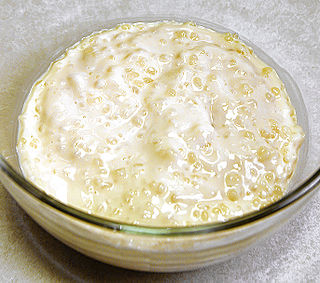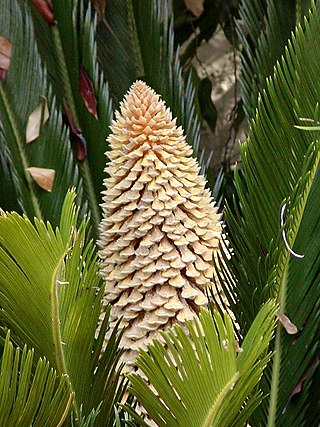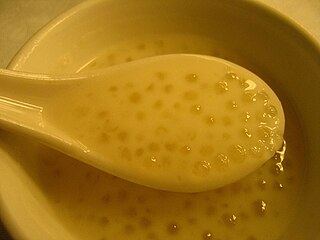Sago is a starch extracted from the stems of metroxylon sagu palms.
Contents
Sago may also refer to:
Sago is a starch extracted from the stems of metroxylon sagu palms.
Sago may also refer to:
Palm most commonly refers to:

Tapioca is a starch extracted from the tubers of the cassava plant, a species native to the North and Northeast regions of Brazil, but whose use is now spread throughout South America. It is a perennial shrub adapted to the hot conditions of tropical lowlands. Cassava copes better with poor soils than many other food plants.

Sago is a starch extracted from the pith, or spongy core tissue, of various tropical palm stems, especially those of Metroxylon sagu. It is a major staple food for the lowland peoples of New Guinea and the Maluku Islands, where it is called saksak, rabia and sagu. The largest supply of sago comes from Southeast Asia, particularly Indonesia and Malaysia. Large quantities of sago are sent to Europe and North America for cooking purposes. It is traditionally cooked and eaten in various forms, such as rolled into balls, mixed with boiling water to form a glue-like paste (papeda), or as a pancake.

Pith, or medulla, is a tissue in the stems of vascular plants. Pith is composed of soft, spongy parenchyma cells, which in some cases can store starch. In eudicotyledons, pith is located in the center of the stem. In monocotyledons, it extends only into roots. The pith is encircled by a ring of xylem; the xylem, in turn, is encircled by a ring of phloem.
Sagu or SAGU may refer to:

Tapioca pudding is a sweet pudding made with tapioca and either milk or cream. Coconut milk is also used in cases in which the flavor is preferred or in areas in which it is a commonplace ingredient for cooking. It is made in many cultures with equally varying styles and may be produced in a variety of ways. Its consistency ranges from thin (runny), thick, to firm enough to eat with a fork.

Cycas revoluta is a species of gymnosperm in the family Cycadaceae, native to southern Japan including the Ryukyu Islands. It is one of several species used for the production of sago, as well as an ornamental plant. The sago cycad can be distinguished by a thick coat of fibers on its trunk. The sago cycad is sometimes mistakenly thought to be a palm, although the only similarity between the two is that they look similar and both produce seeds.

Tacca leontopetaloides is a species of flowering plant in the yam family Dioscoreaceae. It is native to the islands of Southeast Asia. Austronesian peoples introduced it as a canoe plant throughout the Indo-Pacific tropics during prehistoric times. It has become naturalized to tropical Africa, South Asia, northern Australia, and Oceania. Common names include Polynesian arrowroot, Fiji arrowroot, East Indies arrowroot, pia, and seashore bat lily.

Metroxylon sagu, the true sago palm, is a species of palm in the genus Metroxylon, native to tropical southeastern Asia. The tree is a major source of sago starch.

Sago pudding is a sweet pudding made by combining sago pearls with either water or milk and adding sugar and sometimes additional flavourings. It is made in many cultures with varying styles, and may be produced in a variety of ways. Southeast Asia, especially Indonesia and Malaysia, produces the majority of sago.

Rødgrød, rote Grütze, or rode Grütt, meaning "red groats", is a sweet fruit dish from Denmark and Northern Germany. The name of the dish in Danish features many of the elements that make Danish pronunciation difficult for non-native speakers, so, literally "red porridge with cream", has been a commonly used shibboleth since the early 1900s.
Sylvestre can refer to:

Mango pomelo sago is a type of contemporary Hong Kong dessert. It usually includes diced mango, pomelo, sago, coconut milk, and milk. It can be found in many Chinese restaurants and dessert stores in Hong Kong, as well as in Singapore, Malaysia, Guangdong, Taiwan and Papua New Guinea. Over time, this dessert has evolved into many different variations; for example, it can serve as a flavor for other desserts and drinks.

Papeda, or bubur sagu, is a type of congee made from sago starch. It is a staple food of the people indigenous to Eastern Indonesia, namely parts of Sulawesi, the Maluku Islands and coastal Papua. It is also widespread in Papua New Guinea and serves as the counterpart to central and western Indonesian cuisines that favour rice as their staple food.

Rhynchophorus bilineatus, common name Black Palm Weevil, is a species of beetles belonging to the family Curculionidae.

Metroxylon vitiense is a species of flowering plant in the family Arecaceae, endemic to the islands of Fiji, Ovalau, and Vanua Levu in Fiji. There is only one confirmed occurrence of M. vitiense on Vanua Levu, just outside Savusavu. Despite it being considered a threatened species by the IUCN, as of February 2013 M. vitiense was still unprotected by Fijian regulations and international legislation. It has also been reported from the nearby islands of Wallis and Futuna.

Sago soup or Sai mai lou is a type of tong sui dessert in Cantonese cuisine, which is also a variant of tapioca pudding. It is basically made by pearl tapioca (sago), coconut milk and evaporated milk. The dish is traditionally prepared using sago starch, which is derived from sago palm pith. Other ingredients can also be added, such as taro, pumpkin, mango, etc.

A tapioca pearl, also known as tapioca ball, is an edible translucent sphere produced from tapioca, a starch made from the cassava root. They originated as a cheaper alternative to sago in Southeast Asian cuisine. When used as an ingredient in bubble tea, they are most commonly referred to as pearls or boba. The starch pearls are typically five to ten millimeters in diameter. By adding different ingredients, like water, sugar, or some other type of sweetener like honey, tapioca pearls can be made to vary in color and in texture. Various forms of tapioca pearls include black, flavored, popping, mini, and clear. Tapioca pearls are commonly soaked in sugar syrup to make them sweet and chewy. In teas, they are often added for their texture, with the flavor being provided by the drink itself.

Sagu is a southern Brazilian dessert, made with tapioca pearls, sugar and red wine. It is typical of the state of Rio Grande do Sul, but also consumed in Santa Catarina and Paraná.

Kue bangkit is a small biscuit in Malay cuisine made from sago starch, commonly found amongst the Malay communities in Brunei, Indonesia, Malaysia and Singapore. This biscuit has various colours, ranging from white, yellowish to brown, depending on the additional ingredients.